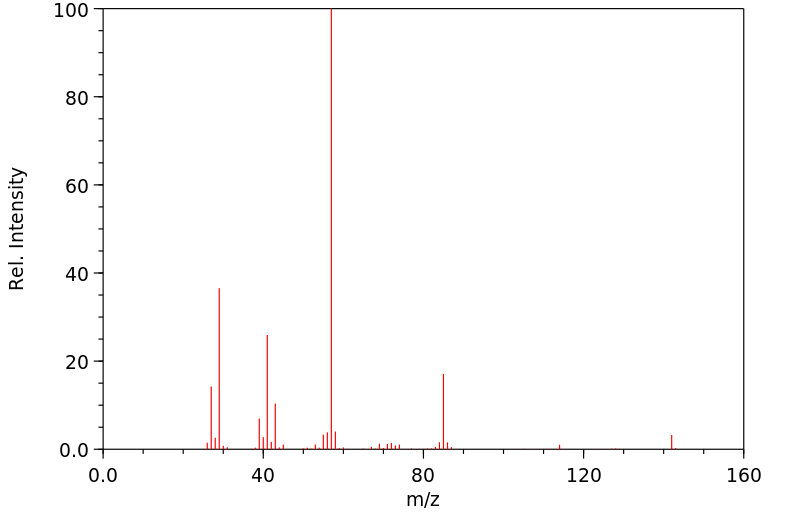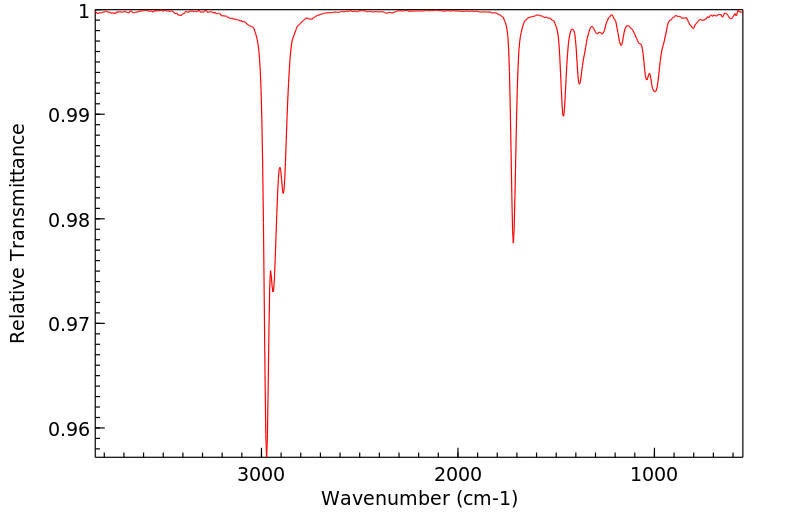3,5-二甲基-4-庚酮 | 19549-84-9
中文名称
3,5-二甲基-4-庚酮
中文别名
——
英文名称
3-butyl ketone
英文别名
di-sec-butyl ketone;3,5-dimethyl-4-heptanone;methyl-n-propyl ketone;3,5-dimethyl-heptan-4-one;3,5-Dimethyl-heptan-4-on;α.α-Dimethyl-α.α'-diaethyl-aceton;methyl-propyl ketone;Di-sek.-butyl-keton;3,5-Dimethylheptan-4-one
CAS
19549-84-9
化学式
C9H18O
mdl
——
分子量
142.241
InChiKey
VZXXYILNWWRSGE-UHFFFAOYSA-N
BEILSTEIN
——
EINECS
——
-
物化性质
-
计算性质
-
ADMET
-
安全信息
-
SDS
-
制备方法与用途
-
上下游信息
-
文献信息
-
表征谱图
-
同类化合物
-
相关功能分类
-
相关结构分类
物化性质
-
熔点:-18.52°C (estimate)
-
沸点:162 °C
-
密度:0.826
-
闪点:46 °C
-
稳定性/保质期:
遵照规定使用和储存,则不会分解。
计算性质
-
辛醇/水分配系数(LogP):2.7
-
重原子数:10
-
可旋转键数:4
-
环数:0.0
-
sp3杂化的碳原子比例:0.89
-
拓扑面积:17.1
-
氢给体数:0
-
氢受体数:1
安全信息
-
危险等级:3.2
-
安全说明:S16
-
危险类别码:R10
-
海关编码:2914190090
-
包装等级:III
-
危险类别:3.2
-
危险品运输编号:UN 1224
-
储存条件:应存放在阴凉干燥处。
SDS
| Name: | 3 5-Dimethyl-4-heptanone 97+% Material Safety Data Sheet |
| Synonym: | |
| CAS: | 19549-84-9 |
Synonym:
Section 2 - COMPOSITION, INFORMATION ON INGREDIENTS
| CAS# | Chemical Name | content | EINECS# |
| 19549-84-9 | 3,5-Dimethyl-4-heptanone | 97+ | 243-150-4 |
Risk Phrases: 10
Section 3 - HAZARDS IDENTIFICATION
EMERGENCY OVERVIEW
Flammable.The toxicological properties of this material have not been fully investigated.
Potential Health Effects
Eye:
May cause eye irritation. May cause chemical conjunctivitis and corneal damage.
Skin:
May cause irritation and dermatitis. May cause cyanosis of the extremities.
Ingestion:
May cause gastrointestinal irritation with nausea, vomiting and diarrhea. The toxicological properties of this substance have not been fully investigated. Ingestion of large amounts may cause CNS depression.
Inhalation:
May cause respiratory tract irritation. The toxicological properties of this substance have not been fully investigated. Aspiration may lead to pulmonary edema. Vapors may cause dizziness or suffocation.
May cause burning sensation in the chest.
Chronic:
No information found.
Section 4 - FIRST AID MEASURES
Eyes: Flush eyes with plenty of water for at least 15 minutes, occasionally lifting the upper and lower eyelids. Get medical aid.
Skin:
Get medical aid. Flush skin with plenty of water for at least 15 minutes while removing contaminated clothing and shoes. Wash clothing before reuse.
Ingestion:
Never give anything by mouth to an unconscious person. Get medical aid. Do NOT induce vomiting. If conscious and alert, rinse mouth and drink 2-4 cupfuls of milk or water.
Inhalation:
Remove from exposure and move to fresh air immediately. If not breathing, give artificial respiration. If breathing is difficult, give oxygen. Get medical aid.
Notes to Physician:
Section 5 - FIRE FIGHTING MEASURES
General Information:
As in any fire, wear a self-contained breathing apparatus in pressure-demand, MSHA/NIOSH (approved or equivalent), and full protective gear. Vapors may form an explosive mixture with air.
Vapors can travel to a source of ignition and flash back. During a fire, irritating and highly toxic gases may be generated by thermal decomposition or combustion. Will burn if involved in a fire. Use water spray to keep fire-exposed containers cool. Water may be ineffective. Material is lighter than water and a fire may be spread by the use of water. Containers may explode in the heat of a fire.
Flammable liquid and vapor. Vapors may be heavier than air. They can spread along the ground and collect in low or confined areas.
Extinguishing Media:
For small fires, use dry chemical, carbon dioxide, water spray or alcohol-resistant foam. For large fires, use water spray, fog, or alcohol-resistant foam. Use water spray to cool fire-exposed containers. Water may be ineffective. Use agent most appropriate to extinguish fire. Do NOT use straight streams of water.
Section 6 - ACCIDENTAL RELEASE MEASURES
General Information: Use proper personal protective equipment as indicated in Section 8.
Spills/Leaks:
Absorb spill with inert material (e.g. vermiculite, sand or earth), then place in suitable container. Clean up spills immediately, observing precautions in the Protective Equipment section. Remove all sources of ignition. Use a spark-proof tool. Provide ventilation. A vapor suppressing foam may be used to reduce vapors.
Section 7 - HANDLING and STORAGE
Handling:
Wash thoroughly after handling. Remove contaminated clothing and wash before reuse. Use only in a well-ventilated area. Ground and bond containers when transferring material. Use spark-proof tools and explosion proof equipment. Avoid contact with eyes, skin, and clothing. Empty containers retain product residue, (liquid and/or vapor), and can be dangerous. Keep container tightly closed. Keep away from heat, sparks and flame. Avoid ingestion and inhalation. Do not pressurize, cut, weld, braze, solder, drill, grind, or expose empty containers to heat, sparks or open flames.
Storage:
Keep away from heat, sparks, and flame. Keep away from sources of ignition. Store in a tightly closed container. Store in a cool, dry, well-ventilated area away from incompatible substances.
Flammables-area.
Section 8 - EXPOSURE CONTROLS, PERSONAL PROTECTION
Engineering Controls:
Facilities storing or utilizing this material should be equipped with an eyewash facility and a safety shower. Use adequate general or local explosion-proof ventilation to keep airborne levels to acceptable levels.
Exposure Limits CAS# 19549-84-9: Personal Protective Equipment Eyes: Wear appropriate protective eyeglasses or chemical safety goggles as described by OSHA's eye and face protection regulations in 29 CFR 1910.133 or European Standard EN166.
Skin:
Wear appropriate protective gloves to prevent skin exposure.
Clothing:
Wear appropriate protective clothing to prevent skin exposure.
Respirators:
A respiratory protection program that meets OSHA's 29 CFR 1910.134 and ANSI Z88.2 requirements or European Standard EN 149 must be followed whenever workplace conditions warrant respirator use.
Section 9 - PHYSICAL AND CHEMICAL PROPERTIES
Physical State: Liquid
Color: clear, colorless
Odor: None reported.
pH: Not available.
Vapor Pressure: Not available.
Viscosity: Not available.
Boiling Point: 162 deg C @ 760.00 mmHg
Freezing/Melting Point: Not available.
Autoignition Temperature: Not applicable.
Flash Point: 46 deg C ( 114.80 deg F)
Explosion Limits, lower: Not available.
Explosion Limits, upper: Not available.
Decomposition Temperature:
Solubility in water:
Specific Gravity/Density: 0.8260 g/cm3
Molecular Formula: C9H18O
Molecular Weight: 142.24
Section 10 - STABILITY AND REACTIVITY
Chemical Stability:
Stable under normal temperatures and pressures.
Conditions to Avoid:
Incompatible materials, ignition sources, excess heat, strong oxidants.
Incompatibilities with Other Materials:
Strong bases, strong oxidizing agents, strong reducing agents.
Hazardous Decomposition Products:
Carbon monoxide, irritating and toxic fumes and gases, carbon dioxide.
Hazardous Polymerization: Has not been reported.
Section 11 - TOXICOLOGICAL INFORMATION
RTECS#:
CAS# 19549-84-9 unlisted.
LD50/LC50:
Not available.
Carcinogenicity:
3,5-Dimethyl-4-heptanone - Not listed by ACGIH, IARC, or NTP.
Section 12 - ECOLOGICAL INFORMATION
Section 13 - DISPOSAL CONSIDERATIONS
Dispose of in a manner consistent with federal, state, and local regulations.
Section 14 - TRANSPORT INFORMATION
IATA
Shipping Name: KETONES, LIQUID, N.O.S.*
Hazard Class: 3
UN Number: 1224
Packing Group: III
IMO
Shipping Name: KETONES, LIQUID, N.O.S.
Hazard Class: 3.3
UN Number: 1224
Packing Group: III
RID/ADR
Shipping Name: KETONES, N.O.S.
Hazard Class: 3
UN Number: 1224
Packing group: III
Section 15 - REGULATORY INFORMATION
European/International Regulations
European Labeling in Accordance with EC Directives
Hazard Symbols: Not available.
Risk Phrases:
R 10 Flammable.
Safety Phrases:
S 9 Keep container in a well-ventilated place.
S 16 Keep away from sources of ignition - No
smoking.
S 28A After contact with skin, wash immediately with
plenty of water.
S 33 Take precautionary measures against static
discharges.
S 37 Wear suitable gloves.
S 45 In case of accident or if you feel unwell, seek
medical advice immediately (show the label where
possible).
WGK (Water Danger/Protection)
CAS# 19549-84-9: No information available.
Canada
None of the chemicals in this product are listed on the DSL/NDSL list.
CAS# 19549-84-9 is not listed on Canada's Ingredient Disclosure List.
US FEDERAL
TSCA
CAS# 19549-84-9 is not listed on the TSCA inventory.
It is for research and development use only.
SECTION 16 - ADDITIONAL INFORMATION
N/A
上下游信息
-
下游产品
中文名称 英文名称 CAS号 化学式 分子量 —— 3-ethyl-3,5-dimethyl-heptan-4-one 51220-08-7 C11H22O 170.295
反应信息
-
作为反应物:描述:参考文献:名称:Nasarow, Chemische Berichte, 1937, vol. 70, p. 620摘要:DOI:
-
作为产物:描述:参考文献:名称:Lion,C.; Dubois,J.-E., Bulletin de la Societe Chimique de France, 1973, p. 2673 - 2676摘要:DOI:
-
作为试剂:描述:1-碘-15-甲基-十六烷 、 3羰基茚酯酸甲酯 在 3,5-二甲基-4-庚酮 、 potassium carbonate 作用下, 生成 32-methyl-tritriacontan-16-one参考文献:名称:Staellberg-Stenhagen; Stenhagen, Journal of Biological Chemistry, 1948, vol. 173, p. 398摘要:DOI:
文献信息
-
[EN] MYCOPHENOLIC ACID RECYCLING IN A METHOD FOR THE PREPARATION OF MYCOPHENOLATE MOFETIL<br/>[FR] RECYCLAGE D'ACIDE MYCOPHÉNOLIQUE DANS UN PROCÉDÉ DE PRÉPARATION DE MYCOPHÉNOLATE MOFÉTIL申请人:DSM IP ASSETS BV公开号:WO2009010503A1公开(公告)日:2009-01-22The present invention provides a method for the preparation of mycophenolate mofetil wherein mycophenoiic acid is mixed with 2-morpholinoethanol in a water-immiscible solvent, followed by addition of water and adjustment of the pH to a value ranging from 0 to 3 or ranging from 7 to 10 and separating the organic and aqueous phases. Mycophenolate mofetil is isolated from the relevant phase and the mycophenoiic acid present in the alternate phase is re-used in a conversion of mycophenoiic acid to mycophenolate mofetil.
-
Catalyst composition for hydrogenation and method for hydrogenation using the same申请人:Asahi Kasei Chemicals Corporation公开号:US10016749B2公开(公告)日:2018-07-10A catalyst composition for hydrogenation including (A) to (D), in which a mass ratio ((C)/(A)) is 0.1 to 4.0 and a mass ratio ((D)/(A)) is 0.01 to 1.00, (A): a titanocene compound represented by formula (1), (wherein R5 and R6 are any group selected from hydrogen, a hydrocarbon group having 1 to 12 carbon atoms, an aryloxy group, an alkoxy group, a halogen group, and a carbonyl group. R1 and R2 are any group selected from the group consisting of hydrogen and a hydrocarbon group having 1 to 12 carbon atoms, and R1 and R2 are not all hydrogen atoms or all a hydrocarbon group having 1 to 12 carbon atoms), (B): a reductant formed from a compound containing an element selected from the elements Li, Na, K, Mg, Zn, Al, and Ca, (C): an unsaturated compound having a molecular weight of 400 or less, and (D): a polar compound.
-
Palladium(II)-Catalyzed Site-Selective C(sp<sup>3</sup> )−H Alkynylation of Oligopeptides: A Linchpin Approach for Oligopeptide-Drug Conjugation作者:Tao Liu、Jennifer X. Qiao、Michael A. Poss、Jin-Quan YuDOI:10.1002/anie.201706367日期:2017.8.28C(sp3)−H alkynylation of oligopeptides was developed with tetrabutylammonium acetate as a key additive. Through molecular design, the acetylene motif served as a linchpin to introduce a broad range of carbonyl‐containing pharmacophores onto oligopeptides, thus providing a chemical tool for the synthesis and modification of novel oligopeptide–pharmacophore conjugates by C−H functionalization. Dipeptide
-
Aspartates containing ketimine-groups and their use in coating compositions申请人:Bayer MaterialScience LLC公开号:EP1518852A1公开(公告)日:2005-03-30The present invention relates to novel aspartates, their method of production and the use of these aspartates as reactive components for polyisocyanates in two-component polyurethane coating compositions and for preparing polyurethane prepolymers. The aspartaes are prepared by first reacting a di- or polyamine with an unsaturated ester and then reacting the resultant product with a ketone.
-
[EN] METAL ORGANIC COMPOUNDS<br/>[FR] COMPOSÉS ORGANOMÉTALLIQUES申请人:UMICORE AG & CO KG公开号:WO2021197597A1公开(公告)日:2021-10-07The invention concerns a process for preparing an essentially silicon (Si) free compounds of the general formula [M(O)(OR)y], wherein M = Mo, y = 3 or M = W, y = 3 or 4. Furthermore, it is directed towards compounds obtained by the aforementioned process and towards the use of such an obtained compound. Another objective of the herein described invention are essentially silicon free compounds of the general formula MOXy or [MOXy(solv)p], prepared using the aforementioned process, wherein M = Mo, y = 3 or M = W, y = 3 or 4, X = Cl or Br, solv = an oxidizing agent Z binding or coordinating to M via at least one donor atom, p = 1 or 2. The invention is also directed towards the use of essentially silicon free compounds prepared using the aforementioned process of the general formula MOXy or [MOXy(solv)p].
表征谱图
-
氢谱1HNMR
-
质谱MS
-
碳谱13CNMR
-
红外IR
-
拉曼Raman
-
峰位数据
-
峰位匹配
-
表征信息
同类化合物
(反式)-4-壬烯醛
(s)-2,3-二羟基丙酸甲酯
([1-(甲氧基甲基)-1H-1,2,4-三唑-5-基](苯基)甲酮)
(Z)-4-辛烯醛
(S)-氨基甲酸酯β-D-O-葡糖醛酸
(S)-3-(((2,2-二氟-1-羟基-7-(甲基磺酰基)-2,3-二氢-1H-茚满-4-基)氧基)-5-氟苄腈
(R)-氨基甲酸酯β-D-O-葡糖醛酸
(5,5-二甲基-2-(哌啶-2-基)环己烷-1,3-二酮)
(2,5-二氟苯基)-4-哌啶基-甲酮
龙胆苦苷
龙胆二糖甲乙酮氰醇(P)
龙胆二糖丙酮氰醇(P)
龙胆三糖
龙涎酮
齐罗硅酮
齐留通beta-D-葡糖苷酸
鼠李糖
黑芥子苷单钾盐
黑海棉酸钠盐
黑木金合欢素
黑曲霉三糖
黑介子苷
黄尿酸8-O-葡糖苷
麻西那霉素II
麦迪霉素
麦芽糖脎
麦芽糖基海藻糖
麦芽糖1-磷酸酯
麦芽糖
麦芽四糖醇
麦芽四糖
麦芽十糖
麦芽六糖
麦芽五糖水合物
麦芽五糖
麦芽五糖
麦芽五糖
麦芽三糖醇
麦芽三糖
麦芽三糖
麦芽三塘水合
麦芽七糖水合物
麦芽七糖
麦法朵
麦可酚酸-酰基-Β-D-葡糖苷酸
麦利查咪
麝香酮
鹤草酚
鸢尾酚酮 3-C-beta-D-吡喃葡萄糖苷
鸡矢藤苷








